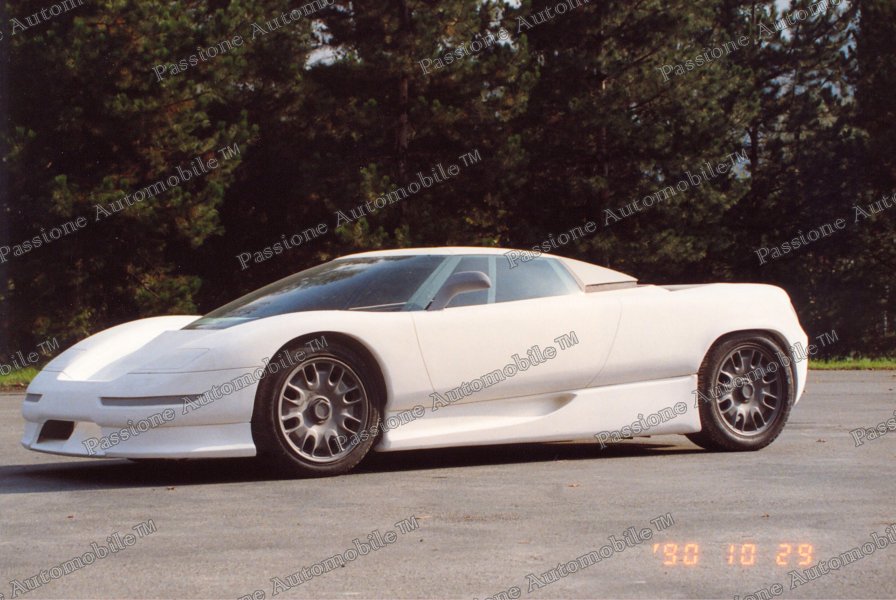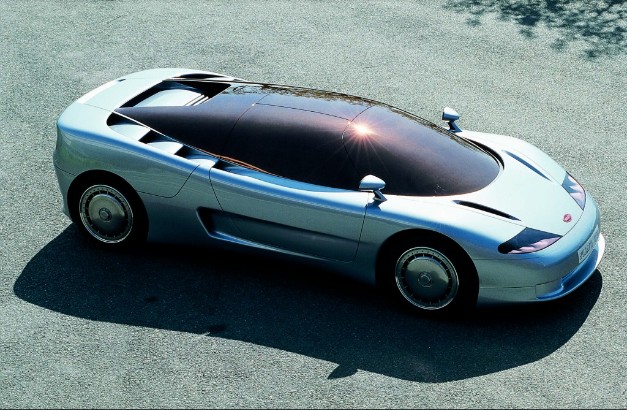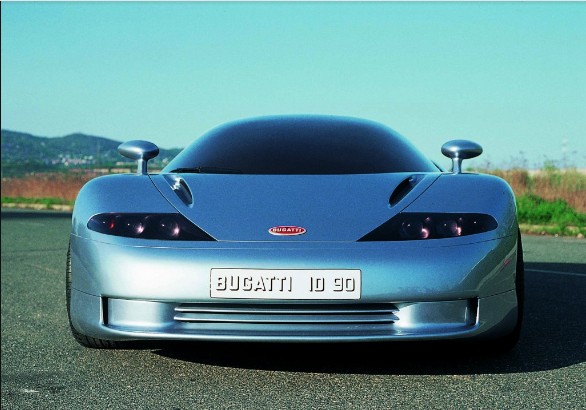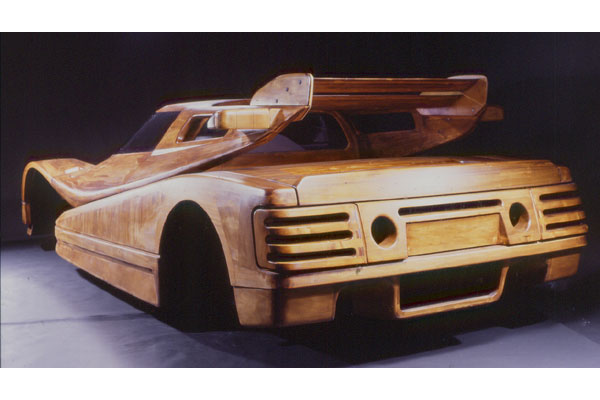

Editor: Jaap Horst

The outcome of the initiative to create a sports car is the resurrection of the prestigious Bugatti brand. Thanks to Eng. Paolo Stanzani we were able to reconstruct the decisive steps.
Top picture: The Bertone proposition for the new Bugatti, a clay model which was destroyed
Jean-Marc Borel is a French professor who regularly, out of passion, visits Sant'Agata Bolognese in his free time. After his first book on Lamborghini, a second one follows on the Countach. Meanwhile, he knows Ferruccio pretty well, and he raises his passion and interest once again to build a Gran Turismo. In the first half of 1985, Ferruccio contacts Eng. Paolo Stanzani, who led Lamborghini Automobili for 10 years as of 1965. Together, they decide to build a 12-cylinder engine and to involve Nuccio Bertone for the body. For the chassis, Marchesi and Bonora are eligible, and for the drawings and calculations, the “three musketeers” of Tecnostile: Bevini, Pedrazzi and Benedetti. It is no coincidence that all these persons in the past have collaborated with Lamborghini.
The same year, Ferruccio and Paolo visit the Turin Car Show. “I’m looking for a car for my daughter”, Ferruccio answers to some journalists they ran into. When they also meet Gianni Agnelli by chance, Ferruccio cannot resist to recommend: “You should do the same as I did. Buy yourself a beautiful domain away from the cities, withdraw and relax”. But the most important contact they make is with Eng. Baraldini, a former colleague at Lamborghini who now works for the company Autexpo in Bolzano. When they reveal their intentions, Baraldini recommends his boss, Romano Artioli be involved. At that time Artioli is the concessionaire for Ferrari in his region and, through a company in Luxembourg, he also sells a bunch of Ferrari's in the Middle East. His company Autexpo is the importer of Suzuki in Italy.
In 1986, a first meeting takes place in "La Fiorita", the vineyard of Ferruccio Lamborghini in Panicarola. Present are Ferruccio, Paolo Stanzani, Nuccio Bertone and Nuccio's right hand, Enzo Prearo. Stanzani has already at that time laid out the broad lines, and it is decided to go with the project. Meanwhile, Baraldini let them know Artioli is very interested in the project. Stanzani meets Artioli for the first time in Verona.
Another meeting is organized in Panicarola for Romano Artioli to present himself. He dreams about reviving one of the big names in the automobile history, and convinces the other 4 of his sufficient financial resources. After this second meeting, Jean-Marc Borel is charged to investigate which names are available on the market. He comes up with 2 potential candidates: Bugatti and Isotta Fraschini. Bugatti is chosen, and Borel starts to negotiate with the French authorities in order to gain the rights to use the name Bugatti.
After the collapse of Bugatti in the 1960s, the French company Messier Hispano detains the rights of the name. This company builds airplane components, and is a division of the French state owned company Snecma. This explains why the French Ministry of Industry must give its approval. The negotiations drag on because they do not want the name to be abused. Borel shows them the first drawings of the project. This convinces the French authorities. They agree the rights may first be borrowed, before they can be acquired.
Artioli and Borel go to Panicarola in 1987 to meet Ferruccio, Stanzani, Bertone and Prearo for the last time. Artioli sees things big, too big in Ferruccio’s and Nuccio’s viewpoint, and both pull out of the project. “Nuccio would never have invested outside Turin. We were only interested in designing and building the coachwork in cooperation with Ferruccio Lamborghini”, Enzo Prearo entrusts us. Lamborghini recommends Stanzani to further follow up the project.
In May 1987, Bugatti International Holding is established, headquartered in Luxembourg. Stanzani becomes director of Bermann, a division of Artioli’s company at San Benedetto Po. This is a kind of smokescreen to keep the project secret. In reality he works 2 to 3 days per week, along with Tecnostile at Modena on the engine and the chassis. In San Benedetto PO work is being done to accessories of Suzuki for the Italian market, and for the design they ask the help of Marcello Gandini, the creator of the Lamborghini Miura.
In October of 1987, Bugatti Automobili SpA is set up, with a start-up capital of 5 billion lire (approximately 2,5 million euro). Bugatti International Holding detains 65% of the capital and the remaining 35% is in the hands of Stanzani and Tecnostile, which is brought in as capital. At Tecnostile, on the road of Modena to Nonantola, a dozen of people are working on the realization of the new sports car.
At the end of 1987, construction of the cultural centre of Bugatti starts in Ora near Bolzano. It will be inaugurated 2 years later. In the meantime Stanzani finds an area of 75,000 m2 at Campogalliano, highly appropriate for the construction of the new Gran Turismo. The area lies right beside the highway that runs from Modena to Verona. In the first half of 1988, construction starts of the test areas, the administrative building, the production hall and the warehouse (in total 13,000 m2). Architect Giampaolo Benedini, a member of the family of Romano Artioli, is in charge of the entire layout of the site. Meanwhile, the capital is raised for all these projects to be funded.
In 1988, they are particularly focused on finding solutions that stress the technical superiority of the project. In order to rival with Ferrari (the F40 is in production), Stanzani chooses several technically very progressive solutions from the outset, including 4 wheel drive, 4 turbos, 5 valves per cylinder, and the use of titanium and composite materials. A number of solutions such as active suspension and carbon disc brakes are considered but not retained. In the meantime, Borel closes partnerships with companies such as Aérospatiale, Elf and Michelin, in order to be able to introduce those solutions on a standard Gran Turismo. This formula will prove to be very successful in the following years. The drawings of the chassis are frozen on October 19, 1988 and the first chassis in aluminium is supplied by Aérospatiale in the first months of 1989. On March 16, 1989 the first engine runs on the test bench. It is time to start thinking on the design of the new Gran Turismo.
4 people get a copy of the drawings of the chassis: Paolo Martin, Giorgetto Giugiaro, Nuccio Bertone and Marcello Gandini. Dario Trucco is designated as liaison in Turin, and has Paolo Martin building a scale model in the months of April and May. Paolo Martin worked for Michelotti in the 1960s, and later on became notorious at Pininfarina. For example, the Ferrari Modulo is designed by him. Even later, he became an independent designer.
Giorgetto Giugiaro gets the drawings but they cannot find an agreement on the way to proceed. For its own account Giugiaro will make a proposal that he presents on the 1990 Turin Car Show, the ID 90.
It is obvious that Nuccio Bertone, involved in the project from the beginning, also gets a chance to develop a proposal. Under the leadership of Marc Deschamps, at that time head designer at Bertone, a 1: 1 scale model is built in clay. Early 1990, it is tested in the wind tunnel of Pininfarina in presence of Oliviero Pedrazzi. However, the cooperation between Bugatti and Bertone becomes more and more difficult. On the one hand, Bugatti will be assembling the coachwork components (made by Golden Car to the design of Gandini) themselves. On the other hand, Nuccio no longer believes in the project, and, on his own initiative, he will end the cooperation in a 2 hours speech with Benedini.
This brings us to Marcello Gandini, who, from the beginning, has an edge over competition. His sensational designs of the Lamborghini Miura, the Countach and the Bravo, are references not to be sneezed at. He also knows Paolo Stanzani and Ferruccio Lamborghini (who remains constantly involved on the background to the Bugatti project) very well from those days. In 1988, he has surprised the world again with the Cizeta V16T (see last Article). The 16-cylinder engine of the Cizeta was designed at Tecnostile by the trio Bevini, Pedrazzi and Benedetti, now housed in Bugatti. At some point, it was envisaged to buy up the project of Claudio Zampolli in order to save time, however, no agreement was reached.
The first design of Gandini is limited to the functional dressing of the car. A model is being built by DMD80 in Venaria.
This small company consists of former employees of Bertone who continue the tradition of building wooden models. At Bertone, the last wooden models are built at the end of the 1970s like for the Lamborghini Athon. Bertone shifts fully into new techniques, using materials such as clay and synthetic resins. Gandini swears by the old tradition on a 1:1 scale. After having built the wooden models of the Cizeta and the Lamborghini Diablo, DMD80 is given the contract to build a wooden model for the prototypes of the new Bugatti. This model is then shipped to Golden Car at Caramagna, where metal workers give shape to the aluminium panels. In the meantime, Design System of Turin is building a wooden model of the dashboard. The owners and designers at Design System, Emanuele Nicosia and Graziano Pagliasso, have in the past worked for Suzuki Italia and are contacted by Romano Artioli personally. They deliver the wooden model of the interior at the end of March 1990. From the start, attention is made to integrate standard components such as switches. The lining of the interior is carried out by Bruno Paratelli near Ferrara. Paratelli has Lamborghini as a regular customer.
In the first half of 1990, the building of the plant at Campogalliano has well advanced. The first prototypes can be assembled in the new premises, where in the meantime, the first engines are turning on the test bench. About €50 million is already invested and a new capital increase is prepared. Mandelli, owner of the company that builds the numerical machinery for the completion of the cast engine, seems keen to participate in the Bugatti venture. Paolo Stanzani had met Mandelli when purchasing machinery for the brand-new factory. He introduces him to Romano Artioli who agrees to a minority interest for Mandelli. However, procedural mistakes during the capital increase would have let to Mandelli ultimately owning the majority of the shares. Artioli becomes aware at the last moment in July, and blocks the situation. Stanzani is sacked the next day, and will be replaced in October 1990 by Eng. Nicola Materazzi, the father of the Ferrari F40.
Some of the other proposals for the new Bugatti:




The ID 90 featured a very elongated glass dome contained within a single rounded curve to achieve the correct aesthetic balance between a sports car and deluxe saloon. As with the Lotus Etna of 1984, the rear part of the dome is empty to leave room for air intakes used to cool the engine.
The design of the alloy rims is a homage to the past: the legendary Bugatti Royale of 1926.
Of course, Giugiaro later went on to design the EB112, EB118, EB218 and EB18/3 Chiron.







The Paolo Martin PM1 Bugatti. Designs and wooden 1:1 model.
More about the Paolo Martin designs www.paolomartindesigner.com. Martin also drew a small Bugatti 1300 (Client: Bugatti SPa), below, of which also a 1/5 model was made.

